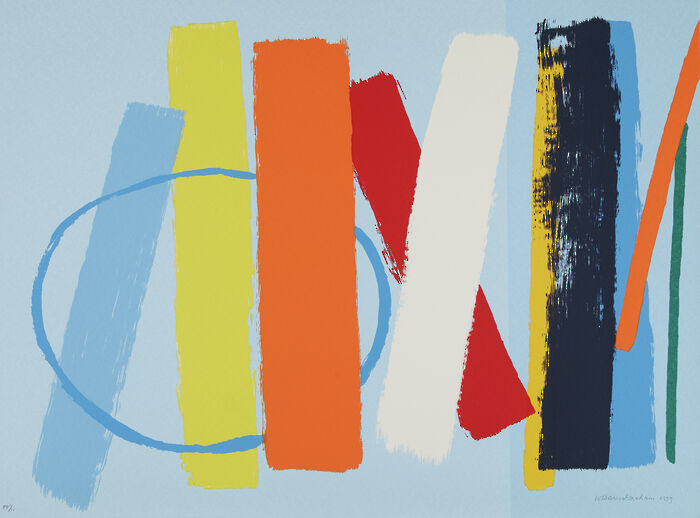‘I Want to be a Machine’: Andy Warhol and Eduardo Paolozzi
Esmee Wright reviews the latest exhibition at the Scottish National Gallery of Modern Art
The snappily christened ‘Modern Two’, the second half of the buildings which makes up the Scottish National Gallery of Modern Art, is currently showing an exhibition of work by Andy Warhol and Eduardo Paolozzi. The exhibition is titled “I want to Be a Machine”, a quote from Andy Warhol, and, at least ostensibly, the exhibition is organised around both artists’ responses to the increased mechanisation of the world around them from their beginnings in the 50s to (in Paolozzi’s case especially) the very near modern day.
Andy Warhol, pop artist extraordinaire is iconic. Everyone knows who he is, or has seen his art in some way. Eduardo Paolozzi, I discovered when telling my friends about this exhibition, is apparently less universally recognisable. Born in Leith, at the edges of Edinburgh, to Italian immigrants in 1924, he died only in 2005, having created many notable works of art, and having been knighted for his for his achievements as a sculptor.
Paolozzi’s lack of fame was, to me, somewhat bemusing. From childhood, I have seen and interacted with Paolozzi’s work. His sculpture “The Manuscript of Monte Cassino” sits in front of St Mary’s Catholic Cathedral in Edinburgh, next to John Lewis, and is regularly used as an impromptu climbing frame by children on a Sunday, whether they are coming from church or merely a pilgrimage to the John Lewis soft furnishings department. It was built as a monument to the devastation of the Second World War, something which as the child of Italian immigrants, Paolozzi suffered from in a very particular manner. His father, grandfather and uncle were interned as enemy aliens and drowned when the boat they were being taken to Canada on was hit by a U-Boat. The sculpture itself consists of three monumental body parts, a hand, an ankle and a foot, all dissected by mechanic looking pieces of metal; a testament to the destruction of war, as well as the possibilities for rebuilding.
As Keith Hartley, Chief Curator and Deputy Director of Modern and Contemporary Art at National Galleries Scotland told The Edinburgh Reporter, although Paolozzi did not embrace the ‘Pop Art’ label, he was “invested” in popular culture. This is demonstrated by the collages on show, including ‘Real Gold’ (1949), a mishmash of images exemplifying something of the American ideal, including a corvette style car and ‘Real Gold’ Orange Juice. The exhibition does contain some of the images Paolozzi made to express his malaise when confronted with the modern world, including ‘Take off’ (1950). An ice skater leaping in a pink feathered costume is contrasted with an American WWII Hellcat in take off; an evocation both of the amazing advances humanity has made in art and mechanics, as well as the destructive potential and the fleetingness of the beauty created. The silkscreen prints the gallery has on show also include ‘War Games Revised’ (1967), an image which appears to be taken from a computer game of the era. Yet there is a certain menace also from this dispassionate arrangement of weaponry; as the wall tag suggests, “computers seem to have organised some terrible military strategy to annihilate us”.
Living in post-war Britain, he saw the “new world” being created in image and advertising very differently from the self-proclaimedly “commercial” artist Warhol. Rather than criticise, Warhol embraced and manipulated this new culture, something which, as the exhibition shows, explains exactly why Warhol is the better known of the two. He understood the emerging importance of creating a brand, of selling oneself, and of using bold, striking imagery to do so. His prints of Marilyn Monroe, a series started in 1962, the year she died, are ubiquitous, and for good reason. The numerous bold copies made highlight not just the pervasiveness of celebrity culture, and by extent the power of advertising to artfully bring about that constant presence, but also their ephemeral nature; one moves onto the next one and the next one and the next one, each only very slightly different, each passed across so quickly that nothing is really taken in. If were to be asked which colours were used in the prints shown in this exhibition I would not be able to make more than a vague guess, despite the prominence of the image itself.
Warhol said ‘I want to be a machine’, and his artwork often reflects this drive to create the perfect advertisement as what is essentially a piece of performance art, to spew out print upon print of vivid image to fleetingly capture the attention of a ravaging audience before it moves on to the next big thing, and to be the thing that provides that new stimulus too. Paolozzi, having seen the devastation of war, focused less on the voracity of the culture newly emerging, than on the fact that it existed at all. Human ingenuity had created machines capable of wreaking destruction across continents, and yet that same enterprise wrought the most beautiful things, the danger, and fascination with which he explored across various mediums.
 Comment / Plastic pubs: the problem with Cambridge alehouses 5 January 2026
Comment / Plastic pubs: the problem with Cambridge alehouses 5 January 2026 News / Cambridge academics stand out in King’s 2026 Honours List2 January 2026
News / Cambridge academics stand out in King’s 2026 Honours List2 January 2026 News / Cambridge businesses concerned infrastructure delays will hurt growth5 January 2026
News / Cambridge businesses concerned infrastructure delays will hurt growth5 January 2026 News / AstraZeneca sues for £32 million over faulty construction at Cambridge Campus31 December 2025
News / AstraZeneca sues for £32 million over faulty construction at Cambridge Campus31 December 2025 Interviews / You don’t need to peak at Cambridge, says Robin Harding31 December 2025
Interviews / You don’t need to peak at Cambridge, says Robin Harding31 December 2025









